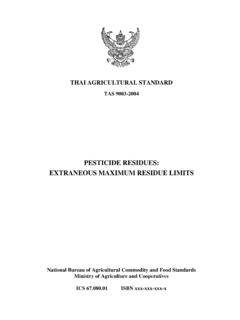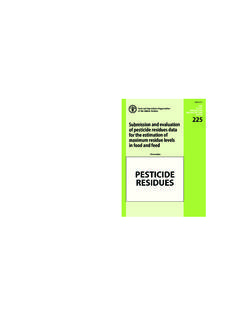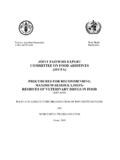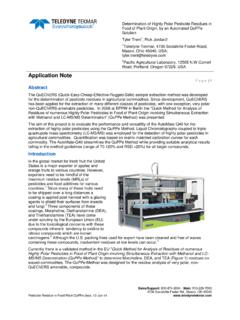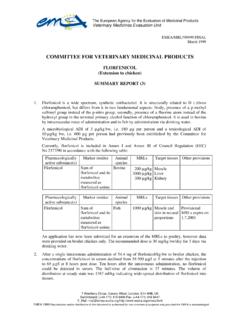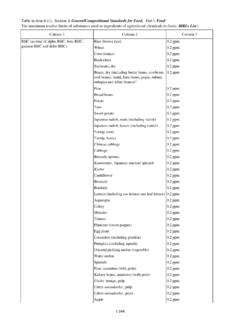Transcription of COMMITTEE FOR VETERINARY MEDICINAL …
1 The European Agency for the Evaluation of MEDICINAL Products7 Westferry Circus, Canary Wharf, London E14 4HB, UKTel: (+44-171) 418 84 00 Fax: (+44-171) 418 84 16 EMEA 1999 Reproduction and/or distribution of this document is authorised for non commercial purposes only provided the EMEA is acknowledgedEMEA/MRL/042/95-FINALCOMMITT EE FOR VETERINARY MEDICINAL PRODUCTSCARPROFENSUMMARY REPORT (1)1. Carprofen, (6-chloro-alpha-methyl-9H-carbazole-2-ac etic acid) is a non-steroidal anti-inflammatorydrug. It is a racemic mixture with the D-isomer being more pharmacologically active than the L-isomer. In VETERINARY medicine it is used in horses and cattle. In cattle the proposed dosage is as a single intravenous or subcutaneous injection. In horses the proposed dosage is bw/day as an intravenous injection or by oral administration for up to 10 The general pharmacological profile of carprofen has been studied in experimental possesses strong anti-inflammatory and analgesic activities.
2 Carprofen has a weak andcompetitive inhibitory effect on the activity of the prostaglandin synthetase enzyme complex; itinhibited the formation of prostaglandin E2 and F2 and was found to be a weak inhibitor ofarachidonate-lipoxygenase activity of human Carprofen is absorbed following oral administration in all the laboratory species studied. In horses,the bioavailability of all oral preparations tested was high (75 to 100%). It is highly protein bound toplasma proteins (greater than 99% in cattle and horses).4. In rats and dogs, Carprofen is metabolised by conjugation and oxidation. In cattle, metabolism isslow with parent compound being the major metabolite in liver, kidney and fat. In horses, themetabolic pathway proposed also involves conjugation and oxidation. The major metabolite inhorses is Carprofen glucuronyl Pharmacokinetic studies from dogs, cattle and horses indicate that carprofen has a small volume ofdistribution and a slow systemic clearance.
3 In dogs the pharmacokinetic parameters followingadministration of the racemate were very similar to those for each isomer plasma elimination half-life in respect of horses and cattle is slow. The half-lives in horses afterintramuscular injection was to hours in horses and hours in ponies. The values ofthe plasma elimination half-life were significantly longer than those of other NSAID's in in respect of cattle, the plasma elimination half-life of Carprofen is in the range of hours. These values are longer than those reported for other NSAID's used in veterinarymedicine. Age dependent pharmacokinetics are shown in calves. The elimination half life in 4 to 7week old calves is approximately twice as long and the systemic clearance is approximately two foldlower in calves that are six weeks in the dog, rat and cattle is predominantly faecal after biliary secretion but in the horse it ismainly A comprehensive range of toxicity studies have been conducted on carprofen.
4 The compound haslow toxic potential following single (acute) administration. Oral LD50 in mice is 282 mg/kg; oralLD50 in rats is 149 EMEA 19997. Several oral repeated dose toxicity studies were carried out in rats and in dogs. While studies wereconducted in accordance with the standards of the time, they were not approved according to were however well conducted and are adequate. In rats administered carprofen by gavage forsix months, doses of up to 5 mg/kg bw/day were well tolerated without mortality or evidence ofsystemic toxicity. Deaths were recorded at doses of 10 mg/kg bw and above. In dogs dose levels of 2and 7 mg carprofen/kg bw/day for up to 1 year were well tolerated with no gross autopsy orhistological The NOEL is based on a 2 year oral toxicity study in rats, given 0, 1, 3 or 10 mg carprofen/kgbw/day in the diet.
5 At a dose of 1 mg/kg bw/day, rats tolerated carprofen well. The 3 mg/kg/day doselevel was only slightly less well tolerated with a slight increase in ulceration or peritonitis resultingfrom perforation of an ulcer of the small intestine. At 10 mg/kg/day there were increases inmortality, intestinal ulceration and Segment I, II and III reproductive toxicity studies were conducted in a number of laboratory teratogenic or fetotoxic effects of Carprofen were found. In some of the studies increasedmortality among pups was considered to be secondary to maternal Carprofen was tested for mutagenicity in a range of tests covering the range of end-points suggestedin EC guidelines: bacterial gene mutation, in vitro gene mutation in mammalian cells, in vitroclastogenicity and an in vivo test for somatic cell mutation. The tests for mutagenicity gaveuniformly negative A 2-year oral toxicity study has been conducted in rats and an 80 week oral carcinogenicity studyhas been presented in respect of mice.
6 No carcinogenic potential for carprofen was detected in Carprofen was not a sensitizer in the guinea pig sensitisation test. The compound was classified asnon irritating when applied to either intact or abraded skin of No data are provided on the microbiological properties of residues . However, there is no evidencefrom the data presented to suggest any microbiological hazard from this class of Carprofen has been used previously for over 10 years in human medicine at dosages of 150 to 600mg per day. During clinical trials in humans carprofen was generally well tolerated. The majority ofadverse effects were transient and mild such as gastro-intestinal discomfort or pain and nausea. Theincidence of side effects in humans is similar to those recorded with aspirin and other non-steroidalanti-inflammatory drugs. Carprofen is no longer marketed for human use having been withdrawnfrom the market on commercial No information is available on the NOEL for pharmacological effects of carprofen in , the metabolites of carprofen were not investigated for pharmacological activity.
7 TheNOEL used in the calculation of the ADI is based therefore on a toxicological study from the 24-month oral toxicity study in the rat. A safety factor of 100 is justified and the ADI established is Residue depletion studies were conducted in calves using radiolabelled carprofen injectedsubcutaneously at a dose of mg/kg bw. The percentage of carprofen in total residue wasapproximately 70% on liver, kidney, muscle and fat within 3 days of dosing, dropping to 65% by 2weeks post treatment. In older animals, both the total residue and the percentage of residue present ascarprofen were lower (approximately half) at equivalent slaughter time points. Carprofen residuesamounted to 48 to 80% of total residues in tissues at 8 days post treatment in these older remaining metabolites were either conjugates of carprofen or hydroxy derivatives.
8 Depletionfrom muscle is rapid, however depletion from the injection site is slower, concentrations of mgcarprofen/kg tissue were present at 8 days post EMEA 1999 Residue depletion studies were conducted in horses using radiolabelled compound at a dose level mg/kg bw. At 7 days post intravenous administration, radioactive residues were detectable inliver and kidney, while residues in muscle and fat were generally at or near the limit of of the nature of the radioactivity 6 hours and 24 hours after intravenous administrationrevealed that parent compound accounted for 33%-36% of total residues in liver, 20% to34% inkidney, 34% to54% in muscle and 34% in A routine analytical method for the determination of residues of carprofen in tissues of cattle is basedon HPLC. The limit of quantification in respect of all tissues is 25 g/kg. However, the method hasnot described according to the ISO 78/2 format and the specificity of the method has not beenadequately demonstrated.
9 A validated routine method for horses has not been Taking into account the pattern of residues depletion in horses and cattle, the following provisionalMRLs are elaborated, with carprofen being the marker residue:Pharmacologicallyactive substanceMarkerresidueAnimalspeciesMRLsT argettissueOther provisionsCarprofenCarprofenEquine1000 g/kg1000 g/kg50 g/kg100 g/kgLiverKidneyMuscleFatProvisional MRLexpires on g/kg1000 g/kg500 g/kg500 g/kgLiverKidneyMuscleFatResidues in treated animals deplete to levels below these limits within 8 days in cattle and within 4days in horses. From the MRLs proposed for cattle the total residue ingested by a consumer wouldbe mg. This represents 55% of the EMEA 1999 LIST OF QUESTIONSThe following questions must be addressed before carprofen can be considered for inclusion into Annex Iof Council Regulation (EEC) 2377/90 in respect of cattle and horses:1. The routine analytical method proposed for cattle should be described according to ISO 78/2 or asimilar international standard.
10 While validation data are presented the method has not been describedaccording to the ISO A validated routine analytical method should be presented in respect of residues of carprofen intissues of While it is unlikely that animals will be treated simultaneously with carprofen and other non-steroidal anti-inflammatory drugs (NSAIDs) the routine analytical method should be capable ofdifferentiating between Carprofen and other NSAIDs. Clarification of the specificity of the routineanalytical method is necessary to differentiate between carprofen and residues of other NSAID scommonly used in VETERINARY medicines intended for use in horses and cattle.










